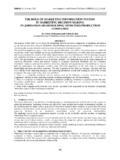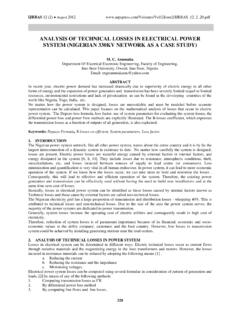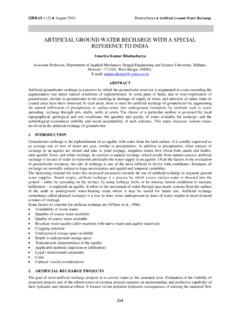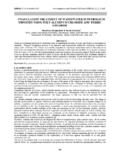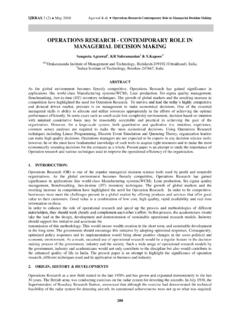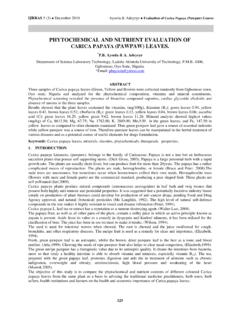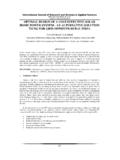Transcription of High Voltage Power Supply for Electro-Optics Q …
1 IJRRAS 3 (2) May 2010 Tamuri & Daud Power Supply for Electro-Optics Applications 143 HIGH Voltage Power Supply FOR Electro-Optics APPLICATIONS A. R. Tamuri, N. Bidin & Y. M. Daud Laser Technology Laboratory, Physics Department Faculty of Science, Universiti Teknologi Malaysia, 81310 Skudai, Johor Bharu, Johor ABSTRACT This paper describes the development of high Voltage Power Supply for Electro-Optics applications. The Power Supply consists of MOSFET driver, Voltage multiplier circuit and Voltage controller. A single timer 555 generates kHz square pulse to drive the Power MOSFET that connected to a standard step up transformer. By using Voltage multiplier technique, the output from secondary transformer was step-up.
2 The variable DC high Voltage output is produced up to 4 kV. The input Voltage as low as 12 volt is required to generate smooth and stable high Voltage output. Keywords: HV Voltage Power Supply , Voltage multiplier and Electro-Optics application 1. INTRODUCTION Electro-Optics devices were widely used for beam modulation, amplitude modulation as well as in Q-switching [1, 2 & 3]. This device required a high Voltage with low current Power Supply (HVPS) in order to have Electro-Optics effect in the crystal [3, 4]. A variable HVPS is necessary for scientific research in order to have better understanding the performance of the fundamental process in Electro-Optics effect. In Q-switching process, a Pockels cell usually operated either half or quarter-wave Voltage that in the range of 3 to 10 kV.
3 However, the conventional Power supplies in principle require bulky transformer as well as high rating capacitor in order to regulate the output Voltage [5]. Toward to smaller, lighter, more efficient and low cost devices, it leads to the development of switch mode Power Supply (SMPS) technology [1-3, 6]. SMPS offer greater efficient compared with convention high Voltage Power Supply because it could control the energy flow with low losses [6]. This circuit also converts low Power DC to high Voltage -high frequency AC [7] then converted back to high Voltage DC. Voltage multiplier is the easiest key point to generate high Voltage in kilovolt region [6-10] that promise simpler, compact and safe compared to convention circuits.
4 Recently, the Voltage multiplier based DC-DC converter and series-connected three-phase symmetrical multistage Voltage multiplier is used to Power -up X-ray Power generator [9-10]. In this present paper, the high Voltage Power Supply for electro -optic applications is discussed. This circuit uses the combination of SMPS technique and Voltage multiplier to generate 4 kV output. 2. THEORY OF OPERATION Figure 1 shows a block diagram of the developed high Voltage Power Supply for Electro-Optics devices. In this development, the input signal unit provide appropriate square signal with frequency of kilohertz. Two square pulses will drive the two MOSFETs which controlled by pulse width modulation (PWM) controller unit. The PWM controller unit is used to control pulse width of the pulse in order to modulate the pulse that used to drive two MOSFET switches.
5 On the other hand, the negative feedback unit also is connected to PWM controller unit. This circuit was used to control the output Voltage as well as the Power correction of the developed circuit. Two MOSFET switches then are used to drive 12 V to a standard center-tap step-up transformer with frequency of kHz. Then, the step-up transformer will convert 12 V input Voltage to approximately 460 VAC. These output Voltage were amplified by using a Voltage multiplier circuit. In this Voltage multiplier circuit consists of eight stages of coupled diode and capacitor that each one of them could regulate 460 VAC to approximately 500 VDC. Finally, in this development, a series of high Power resistors (as Voltage divider) are connected to output Voltage terminal to PWM controller unit.
6 The output of this circuit is called negative feedback signal. In the PWM controller unit, the input signal and negative feedback signal are compared. This circuit will continuously generate input signal to MOSFET switches until, the input signal is same to the signal of negative feedback. IJRRAS 3 (2) May 2010 Tamuri & Daud Power Supply for Electro-Optics Applications 144 Figure 1: Block diagram of developed high Voltage Power Supply . DESIGN AND COMPONENTS SELECTION Figure 2 shows the schematic diagram MOSFET driver circuit. A timer 555 (LM 555) was used to generate kilohertz square wave that directly connected to pin 10 and pin 5 of comparator LM 399. In this circuit, the LM 399 is used as the PWM controller.
7 This PWM controller unit produces two square waves at different polarity (at pin 13 and pin 2) to drive two Power bipolar NPN transistors, 1N3904. Following that, the output from the transistor is used to drive two MOSFETs, IR 710 which connected to both side of primary winding of the standard center tap step-up transformer (CT: 12:460). In order to operate this circuit, the Supply Voltage of 12 V with 5 A is required. The MOSFET switches will turn on and turn off the two MOSFET simultaneously. Consequently, it produces the square wave on the primary winding. As a result, the step up transformer produces 460 VAC at secondary winding. This AC Voltage will be amplifed by using Voltage multiplier circuit up to 4 kV. Figure 2: The schematic diagram MOSFET driver circuit The Voltage multiplier circuit consists of sixteen non-polarize high Voltage capacitor with 680 nF of capacitance couple with 16 of 1N4007 diodes to form eight stages as shown in Figure 3.
8 Each stage consists of two diodes and two capacitors which both of them have rating of 1000 V. This arrangement of Voltage multiplier circuit is based on Villard cascade. In this development, for each stage of Voltage multiplier circuit will produces a smooth 500 VDC. So that, we could easily use the output from each stages depends on our applications need. If we want to amplify to more high output Voltage , we could add more stages but need consider the safety factor as well as input current Supply . The output Voltage of Villard cascade circuit is given as [8]; nnnfCV612132123 (1) where, f is the input frequency, C is capacitance and n is the number of stages, The output Voltage was connected to negative feedback unit (to pin 8 and pin 6 of LM399) that consist of series resistor 16 MegaOhm couple with 20 kiloOhm.
9 As a Voltage divider, this circuit produces 5 V of feedback signals when the developed circuit generates maximum output Voltage of 4 kV. A variable input Voltage in the range 0 to 5 V supplied to pin 9 and pin 7 of the feedback circuit. Then, this Voltage is used as the reference to the input signal from Voltage divider. The output of feedback unit (pin 14 and pin 1) is directly connected to output of PWM Input signal Unit PWM controller unit MOSFET switch Step up Transformer Voltage multiplier Unit Negative feedback unit Output Voltage 4 kV IJRRAS 3 (2) May 2010 Tamuri & Daud Power Supply for Electro-Optics Applications 145 controller circuit (pin 13 and pin 2). If the reference Voltage is bigger than feedback Voltage , the PWM controller unit will continuously generates square pulses.
10 When the Voltage for both reference and feedback at the same value, the PWM controller do not generates the square pulses to MOSFET switches. Consequently, amplification is stopped and the Voltage is remained constant until there have Voltage different of them. By adjusting the reference Voltage , we could vary the output Voltage of the developed circuit from 0 V to maximum of 4 kV. Figure 3: The schematic diagram of 8 stages Voltage multiplier circuit. 4. EXPERIMENTAL SETUP The experimental setup of measurement of developed circuit is shown in Figure 4. The developed high Voltage Power Supply was used to Supply DC Voltage to the Pockels cell driver. A KD*P crystal with dimension of 10x10x50 mm3 was utilized as a Pockels cell in the laser system.

